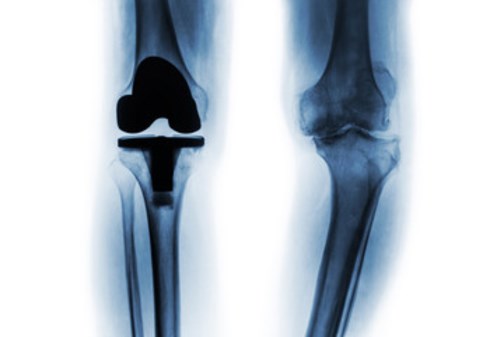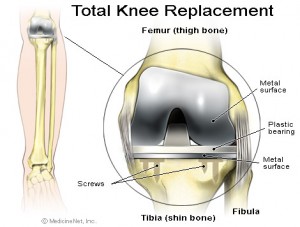Total Knee Replacement Surgery (Total Knee Arthroplasty) in Singapore
A total knee replacement is a surgical procedure whereby the diseased knee joint is replaced with artificial material. In Singapore, the procedure is also referred to as total knee arthroplasty so the two terms are interchangeable.
The knee is a hinge joint which provides motion at the point where the thigh meets the lower leg. The thigh bone abuts the large bone of the lower leg at the knee joint. During a total knee replacement, the end of the femur bone is removed and replaced with a metal shell.
If your knee is severely damaged by arthritis or injury, it may be hard for you to perform simple activities such as walking or climbing stairs. You may even begin to feel pain while you are sitting or lying down.
If medications, changing your activity level, and using walking supports are no longer helpful, you may want to consider total knee replacement surgery. By resurfacing the damaged and worn surfaces of the knee can relieve pain, correct leg deformity and help resume normal activities.
One of the most important orthopaedic surgical advances of the twentieth century, knee replacement was first performed in 1968. Improvements in surgical materials and techniques since then have greatly increased its effectiveness. Approximately 581,000 knee replacements are performed each year in the United States.
How do I Know if I Need Knee Replacement Surgery?
Knee replacement is considered a major surgery and there are many factors to consider first before making a decision. It is a question that cannot be answered easily. Rather, it requires you and your orthopaedic surgeon to sit down and ponder through all the possible options available to you before deciding on it. What exactly is knee replacement surgery? How do you know if you require knee replacement surgery?
Oral Medications Do Not Work
Your doctor will usually prescribe nonsteroidal anti-inflammatory drugs such as Ibuprofen or Naproxen Sodium to help make the pain more bearable and reduce inflammation. However, these drugs are only able to help counteract the pain to a certain extent and they do not treat your knee condition. You should not be consuming drugs for the rest of your life as they might harm your body. After a certain time span and it has no effect, surgery will be required.
Physical Therapy Has Little Effect
Oral medication will often be accompanied by physical therapy sessions. Physical therapy helps to build up the muscles around the knee, strengthening them so that they can better support your knee. It also helps to make the knee joint much more flexible and restore joint mobility. However, when this still does not help, surgery will be required.
Daily Activities Are Limited
When simple daily activities are severely limited due to knee pain, surgery may be the only option left. You do not want your quality of life to be affected by your knee and there is always the option of knee replacement surgery. Some patients may not even be able to sleep as the pain will keep them up throughout the night. For others, simple actions such as walking may also be a chore.
You Wish to Engage in Competitive Sports
This is the most common reason for total knee replacement surgery. Athletes who wish to continue engaging in competitive sports will definitely require surgery to replace the damaged joints with artificial biomaterials in order to regain near full strength and mobility.
There are many reasons for one to undergo knee replacement surgery. Knee replacement surgery is a major surgery and requires one to consider many factors before deciding on it. It does not come cheap and for most patients, physical therapy and medication will usually suffice. If you are seeking a return to sports, knee surgery may be the only viable option for you.
What to Expect During Total Knee Replacement Surgery?
The patient is first taken into the operating room and given anesthesia. After the anesthesia has taken effect, the skin around the knee is thoroughly scrubbed with an antiseptic liquid. The knee is flexed about 90 degrees and the lower portion of the leg, including the foot, is placed in a special device to securely hold it in place during the surgery. Usually a tourniquet is then applied to the upper portion of the leg to help slow the flow of blood during the surgery. An incision of appropriate size is then made.
Total Knee Replacement Video
Removing the Damaged Bone Surfaces
The damaged bone surfaces and cartilage are then removed by the surgeon. Precision instruments and guides are used to help make sure the cuts are made at the correct angles so the bones will align after the new surfaces (implants) are attached.
Small amounts of the bone surface are removed from the front, end, and back of the femur. This shapes the bone so the implants will fit. The amount of bone that is removed depends on the amount of bone that has been damaged by the arthritis.
A small portion of the top surface of the tibia is also removed, making the end of the bone flat. The back surface of the patella (kneecap) is also removed.
Attaching the Implants
An implant is attached to each of the three bones. These implants are designed so that the knee joint will move in a way that is very similar to the way the joint moved when it was healthy. The implants are attached using a special kind of cement for bones.
The implant that fits over the end of the femur is made of metal. Its surface is rounded and very smooth, covering the front and back of the bone as well as the end.
The implant that fits over the top of the tibia usually consists of two parts. A metal baseplate fits over the part of the bone that was cut flat. A durable plastic articular surface is then attached to the baseplate to serve as a spacer between the baseplate and the metal implant that covers the end of the femur.
The implant that covers the back of the patella is also made of a durable plastic.
Artificial knee implants come in many designs. Some designs may have pegs, requiring small holes to be drilled into the bone after the damaged surfaces have been removed. Others may have central stems. In addition, some designs may allow screws to be used on the lower implant to provide added attachment security. The surgeon will choose the implant design that best meets the patient’s needs.
Closing the Wound
If necessary, the surgeon may adjust the ligaments that surround the knee to achieve the best possible knee function.
When all of the implants are in place and the ligaments are adjusted, the surgeon sews the layers of tissue back into their proper position. A plastic tube may be inserted into the wound to allow liquids to drain from the site during the first few hours after surgery. The edges of the skin are then sewn together, and the knee is wrapped in a sterile bandage. The patient is then taken to the recovery room.
Your Recovery Care and Time at Home
Current ten-year survival rates for fixed and mobile bearing unicompartmental knee replacements range from 90% – 95%. The success of your surgery also will depend on how well you follow your orthopaedic surgeon’s instructions at home during the first few weeks after surgery.
Wound Care
You will have stitches or staples running along your wound or a suture beneath your skin on the front of your knee. The stitches or staples will be removed several weeks after surgery. A suture beneath your skin will not require removal.
Avoid soaking the wound in water until the wound has thoroughly sealed and dried. The wound may be bandaged to prevent irritation from clothing or support stockings.
Diet
Some loss of appetite is common for several weeks after surgery. A balanced diet, often with an iron supplement, is important to promote proper tissue healing and to restore muscle strength.
Activity
Exercise is a critical component of home care, particularly during the first few weeks after surgery. You should be able to resume most normal activities of daily living within 3 to 6 weeks following surgery. Some pain with activity and at night is common for several weeks after surgery. Your activity program should include:
- A graduated walking program to slowly increase your mobility, initially in your home and later outside
- Resuming other normal household activities, such as sitting and standing and climbing stairs
- Specific exercises several times a day to restore movement and strengthen your knee. You probably will be able to perform the exercises without help, but you may have a physical therapist help you at home or in a therapy center the first few weeks after surgery.
Driving usually begins when your knee bends sufficiently so you can enter and sit comfortably in your car and when your muscle control provides adequate reaction time for braking and acceleration. Most individuals resume driving approximately 4 to 6 weeks after surgery.
The First 3 Months After Your Knee Replacement Surgery
So what about total knee replacement surgery recovery time? Read on.
During your knee replacement surgery, you will be under general anaesthesia and there will be an incision made on your knee to allow surgical tools to move in and out of the knee. Once the damaged portions of the knee are removed and the artificial joints placed into the knee and attached using adhesive materials, the knee will be sutured together and you will be pushed to the recovery room.
The recovery period starts immediately after the surgery and even though you are still feeling the effects of the anaesthesia, you will be encouraged to start moving your knee. High chance are that you have not used the knee for physical activities for quite some time due to the pain which led to you undergoing the knee replacement surgery. As a result, the muscles are weak and you need to start building up and strengthen the muscles to allow better control of your new joint. A physical therapist will prescribe some physical therapy exercises for you to do yourself at home. You will be able to get discharged around 3 days after surgery and during this period, you will start to learn how to move around with the help of crutches until your knee is able to take your body weight. Once the knee is strengthened and is able to bear weight, you can slowly reduce your dependency on your crutches.
The first 3 months post surgery is a risky period as the replacement joint is still not fully attached to the surrounding muscles and tissues firmly. You knee can often give way so make sure you keep doing strengthening exercises to strengthen the region. You will also feel pain in the knees rather often during this period and this is perfectly normal. You will be prescribed painkillers but do not rely totally on the painkillers. If you notice any abnormal swelling or abnormal pain in the knee, make sure you go back to your surgeon for a check. Although the operating theatre is sterile, infection can still happen but this is rare. If you see any infection in the site of the incision, you need to go back to your surgeon as well. You should aim to regain your knee’s full range of motion within this 3 months and this will help to prevent any scar tissues from building up or arthrofibrosis.
The first 3 months post surgery is totally about recovery and regaining back the functions of your knees. It is probably the toughest part of the whole surgery process and you will feel extremely useless. However it is the most important part and a bad recovery can lead to even more problems in future.
How Can I Manage Pain After My Total Knee Replacement Surgery?
Pain is an unavoidable side effect of any surgery, not just a knee replacement surgery. While patients are anxious to undergo surgery in order to regain back a wholesome quality life, they are often unaware and uneducated about how to manage pain post surgery. The pain is definitely here to stay for awhile and knowing how to manage pain will help you set reasonable recovery goals. In this article’s section, we will talking about how you can manage pain better after your total knee replacement surgery.
Rest
Our body repairs itself only when we are at rest. Surgery is an extremely taxing procedure for our body. Imagine all those stresses and trauma to not just the surgical site but also to the surrounding soft tissues. Therefore, plenty of rest post surgery is extremely important for the body. As a rule of thumb, expect to be immobile for a week post knee surgery. The mass of the surrounding muscles will start to decrease in a medical phenomenon known as muscular atrophy while the knee will be unable to bear your body’s weight. Therefore, do nothing but rest during the first week.
Icing
It is also during this period where pain will be at its max. Therefore, icing is crucial in helping to manage pain. Ice helps to decrease swelling and relief inflammation of the knee. It constricts the blood vessels and reduces blood flow to the area. Icing is convenient and can be done almost everywhere. When you are icing your knee, remember to elevate your knee to above your heart.
Compression
Compression stockings are important as they help to create pressure and increase blood flow in order to prevent blood clots from forming. Compression stockings will also help to relief achiness in the leg.
Medicine
As much as you think you are Hercules, you still need pain relief medication to tide you through the initial tough period. Pain relief medications help to bring down the swelling and provide you relief during periods when you are sleeping. You do not want to lose your sleep constantly due to the pain, do you? However, do not depend too much on the medicine. When the pain gets more bearable, ditch the medication and increase your icing times.
Managing pain post total knee replacement surgery is not difficult if you follow the simple steps listed above. Be mindful not to rush through your recovery process and it may lead to long term complications.
What are the Advantages of Minimally Invasive Surgery for Knee Replacement?
Considering doing minimally invasive surgery for knee replacement? Read on to find out what are the advantages.
Knee replacement is a surgery that is commonly performed with the intention to replace a knee joint damaged due to degenerative diseases. More than half a million people undergo this surgery yearly and this number is set to increase. As its name suggests, minimally invasive surgery is a minimally invasive procedure that involves the usage of small incisions between 3 to 5 inches to carry out the surgery. Unlike its open surgery counterpart, the knee does not need to be cut open and stitched back post operation. This leads to a faster recovery time, shorter hospitalization and also better looking aesthetically. In this article’s section, we will look at some of the advantages of minimally invasive surgery for knee replacement.
Medically, there are no significant differences between a traditional surgery and a minimally invasive surgery. Smaller incisions between 3 to 5 inches are made instead of 8 to 10 inches incisions with traditional methods. In traditional surgery, the quadriceps muscles as well as the tendons at the front of the knee and thigh are cut. In minimally invasive surgery, these two are spared and left untouched. Instead, 3 small incisions are made near the patella in order to insert a camera and robotic arms.
The main aim of minimally invasive surgery is to minimise trauma to the tissue by conventional surgery, leading to less pain, less unwanted injuries, less infections, shorter recovery time and lower cost for the patients. Patients typically require only half the time now to get rid of a walker and use a walking cane to move around. Most importantly, minimally invasive surgery has a higher success rate due to the usage of small robotic arms to aid the surgery. The surgeon is able to view high definition magnified images of the knee throughout the surgery. This will enhance the accuracy as well as ensure a higher success rate.
There are many advantages of minimally invasive knee replacement surgery compared to its traditional counterpart. However, minimally invasive surgery is not for everyone. Patients who suffer from knee deformity are better suited to the traditional type and repeat patients who had knee replacement surgery before will also require traditional surgery. Also, some artificial knee components may not be able to fit through the small incisions. Other than that, higher success rates, lesser pain and lesser trauma are the few strong unique selling points of minimally invasive knee replacement surgery.
Related Knee Replacement Videos
Partial Knee Replacement
Revision Knee Replacement
At the Singapore Sports and Orthopaedic Clinic, our orthopaedic specialists are ready to help you get back to the activities you know and love. Call us today for an appointment @ +65 9734 3087 to get a professional assessment of your condition & start your journey toward a better life!







